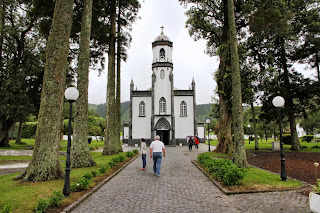The Azores officially the Autonomous Region of the Azores is one of the two autonomous regions of Portugal, composed of nine volcanic islands situated in the North Atlantic Ocean about 1,360 km (850 mi) west of continental Portugal, about 880 km (550 mi) northwest of Madeira, and about 1,925 km (1,196 mi) southeast of Newfoundland. Its main industries are agriculture, dairy farming (for cheese and butter products primarily), livestock ranching, fishing, and tourism, which is becoming the major service activity in the region. In addition to this, the government of the Azores employs a large percentage of the population directly or indirectly in many aspects of the service and tertiary sectors.
There are nine major Azorean islands and an islet cluster, in three main groups. These are Flores and Corvo, to the west;Graciosa, Terceira, São Jorge, Pico, and Faial in the centre; and São Miguel, Santa Maria, and the Formigas Reef to the east. They extend for more than 600 km (370 mi) and lie in a northwest-southeast direction.
All the islands have volcanic origins, although some, such as Santa Maria, have had no recorded activity since the islands were settled. Mount Pico, on the island of Pico, is the highest point in Portugal, at 2,351 m (7,713 ft). The Azores are actually some of the tallest mountains on the planet, measured from their base at the bottom of the ocean to their peaks, which thrust high above the surface of the Atlantic.
Because these once-uninhabited and remote islands were settled sporadically over a span of two centuries, their culture, dialect, cuisine, and traditions vary considerably.
The island is magnificiant. This was my 2nd visit here, some spots were familiar for me and some new.
The best way to explore the island is on your own. The half day tour cost 60 euros after some negotiation.
The pineapple plantation is very interesting, and the fruit has really fantastic taste. MUST TO TRY!
Lagoa das Sete Cidades "Lagoon of the Seven Cities") is a twin-lake situated in the crater of a massive volcano on the Portuguese archipelago of the Azores. It consists of two ecologically-different small-lakes connected by a narrow passage (and crossed by a bridge), located inside a dormant volcano on the western third of the island of São Miguel. The Lagoa das Sete Cidades part of a natural landscape of communitarian interest: it is the largest body of water in the region and one of the most important freshwater resources in the archipelago.
Ponta Delgada is the largest municipality and administrative capital of the Autonomous Region of the Azores in Portugal. It is located on São Miguel Island, the largest and most populous in the archipelago. The population in 2011 was 68,809 in an area of 232.99 km².
Our ship docked just in the downtown area, so it was a very pleasent walk from the ship to the heart of the city.
















No comments:
Post a Comment